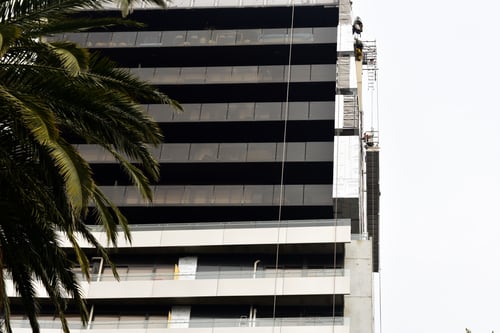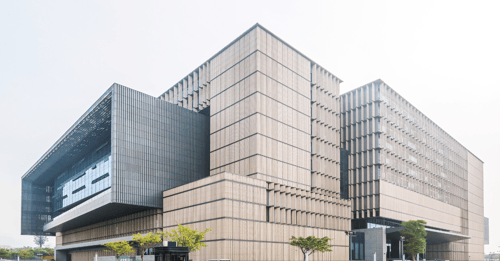The evolution of architectural styles has been significantly shaped by modern façade design principles within Australia and New Zealand, these principles embody technology advancements while responding to design aesthetics and environmental considerations.
The last two decades have demonstrated the rise in glass encased skyscrapers across city skylines. The Australian climate highlights how glass-encased buildings impact the environment and the industrial and business sectors. The energy efficiency of these skyscrapers underscores the importance of façade cladding in enhancing building performance.
Application of Modern Facade Cladding Systems
Modern architectural cladding systems are used across a large scope of commercial and industrial building projects throughout Australia and New Zealand. The façade cladding systems incorporate both modern and traditional building elements, forming unique and sustainable cladding systems that are both picturesque and practical.
Stone cladding is popular within modern construction, due to the unique finish of the stone, while installers avoid the time-consuming process of constructing stone walls.
Terracotta cladding is a pioneering material in sustainable cladding, impacting a building’s aesthetic and functionality. Terracotta façade cladding systems are a rainscreen façade system that add a natural finish to a design and can be utilised in both new builds and renovation projects.
Ceramic façade cladding is a sustainable material that offers a high calibre of moisture regulation through the ventilation space between the building and the cladding, offering energy efficiency.
Concrete, steel and aluminium façade cladding are preeminent in modern architecture. A powerful mark in design, concrete façade cladding is formed through concrete panels, the concrete is commonly mixed with an array of coloured materials to soften the aesthetic of the concrete. Steel and aluminium façade cladding is also used throughout modern architecture due to the sleek and versatile finish of the materials. 
Array at 1 Eden Park, Macquarie Park, NSW as seen on: https://architectus.com.au/projects/array-at-1-eden-park-drive/
The first building project following the Code changes in 2019, Array at 1 Eden Park, exhibits the impact cladding can make on a building’s aesthetic and functionality. The building has an open concept to the east of the building with the facades blocking harsh sunlight from the north and west of the structure. The contemporary design consists of 40% glazed panels with 60% white terracotta cladding forming an elegant pattern across the structure.

1 Spring Street Melbourne, VIC as seen on: https://architectus.com.au/projects/1-spring-street/
1 Spring Street reflects the prediction of an increase in photovoltaic use and self-shading in architecture. The project embodies a self-shading system through the innovative staggering of the façade elements, optimising shading and dictating where the natural light flows through to high traffic areas.
Benefits of Modern Facade Cladding in Architecture
Modern façade cladding provides a range of architectural design benefits spanning across economic, aesthetic and environmental elements; while simultaneously enhancing the performance, sustainability credentials and the safety compliance of a structure.
Aesthetic Benefits
Design Flexibility
Modern cladding materials encompass a broad range of design elements including an array of colours, textures and forms. Cladding materials such as aluminium panels and natural materials like terracotta can create a sleek, modern design or traditional aesthetic while enhancing the visual appeal of a structure.
Integration with Environment
Facade cladding can be designed to harmonise with the surrounding environment, both urban and natural landscapes, helping buildings blend seamlessly into their surroundings.
Economic Benefits
Durability and Low Maintenance
Materials used in modern cladding such as aluminium, terracotta and brick are resistant to weathering, corrosion and fading, reducing long-term maintenance costs.
Energy Efficiency
Cladding systems can incorporate insulation materials improving the building's thermal performance, leading to reduced energy consumption and lowered operational costs over time.
Speed of Construction
Prefabricated cladding systems simplify the installation process, and as a result, accelerate construction schedules. This can result in reduced labour costs and earlier occupancy of a building, generating potential savings for both developers and building owners.
Environmental Benefits
Sustainable Materials
Various modern cladding materials are produced using renewable resources and sustainable practices. For example, composite materials can incorporate recycled content, and natural materials like timber can be sourced from environmentally responsible managed forests.
Energy Efficiency
Lowering greenhouse gas emissions is a direct result of improved thermal insulation, cladding materials can reduce the buildings energy consumption from reducing the need for heating and cooling inside the structure.
Green wall façade systems, also known as “vertical green walls,” where plants envelope the exterior wall of a structure improves acoustic performance, thermal insulation and indoor air quality.
A rainscreen façade features a two-layer system for excellent waterproofing, durability, and thermal efficiency. It deflects most moisture with its outer layer, while the inner cavity handles any remaining moisture through ventilation and drainage. This system enhances insulation while reducing energy consumption and protects buildings from weather damage.
Recyclability
Cladding materials, such as terracotta and fibre cement, are recyclable at the end of their lifecycle and contribute to the circular economy, guiding the movement towards more sustainable opportunities.
EPD
An EPD is an independently verified and registered document that provides clear information on a product's environmental impact throughout its life cycle, from production to disposal. By specifying products with an EPD, architects can be confident in their sustainability and minimize environmental impact.
Building Performance and Safety Compliance
Weather Protection
Façade cladding acts as a protective barrier against weather elements such as rain, wind and UV radiation, in result the building’s exterior and underlying structural elements are protected against deterioration and therefor extend the lifespan of a structure.
Fire Resistance
Modern cladding materials are meticulously designed to meet fire safety standards and regulations. Both metal and fibre cement are fire-resistant materials that help contain fires, act as a preventative measure and enhance the safety of a structure.
Acoustic Performance
Cladding systems can act as acoustic insulation, reducing noise transmissions from external resources and improving indoor acoustics; this being highly beneficial for buildings located within urban areas.
Future Trends in Modern Facades
The future of architecture is being shaped through emerging technologies and design philosophies, as these innovations continue to evolve, facade cladding remains at the forefront of architectural and engineering advancements.
Parametric Design Architecture illustrates the rise of modern technologies in the industry, the approach uses data and algorithms to generate intricate forms. Parametric Design offers architects the opportunity to optimize the functionality and aesthetic of a structure, through the ability to manipulate standard parameters.
Generative façade design presents the opportunity for continuous innovation and growth. This design principle capitalises on computational processes and algorithms to analyse and explore design potential. The data input to customise the designs includes elements such as material properties, environmental factors and aesthetic options.
Smart facades illustrate how the integration of technology in design can shape design concepts in architecture. Smart facades can adjust to the surrounding environment through adjusting ventilation, lighting and shading. The Internet of Things (IoT) and artificial intelligence (AI) are the applications used in this advanced technology, enhancing the occupants experience.
There are an array of new materials and methods that are gaining popularity, benefiting both industrial and commercial architecture. A new material gaining popularity includes composite materials. These materials can consist of two or more distinct components combined to create a stronger, more durable product. Natural materials such as plants, stone and woods are also being utilised more frequently in design, forming a connection with the natural world.
Tying into natural elements, biophilic design continues to gain popularity. These facades create a connection to nature while contributing to the sustainability of the structure. Interactive facades are also becoming an attractive design element, including dynamic building features, such as adjustable shading and lighting, and moving panels.
Conclusion
Modern facade cladding materials offer multifaceted benefits that encompass aesthetics, economic and environmental considerations, contributing to sustainability goals. Through enhancing building performance while complying with safety standards, the materials also contribute to the overall functionality and safety of architectural designs in a diverse range of environments.
Future trends in modern facades indicate that the incorporation of advanced technology and the manipulating of natural elements will continue to evolve and impact modern facades and architectural styles.


.jpg?width=500&name=Wolfshof%20(5).jpg)
